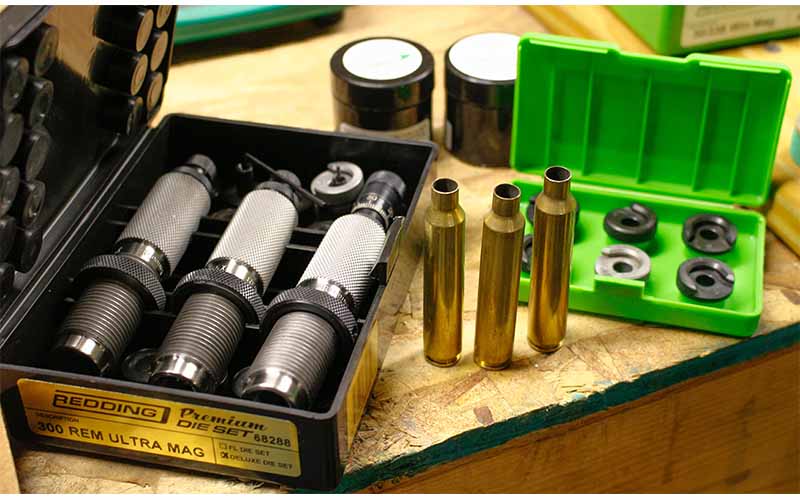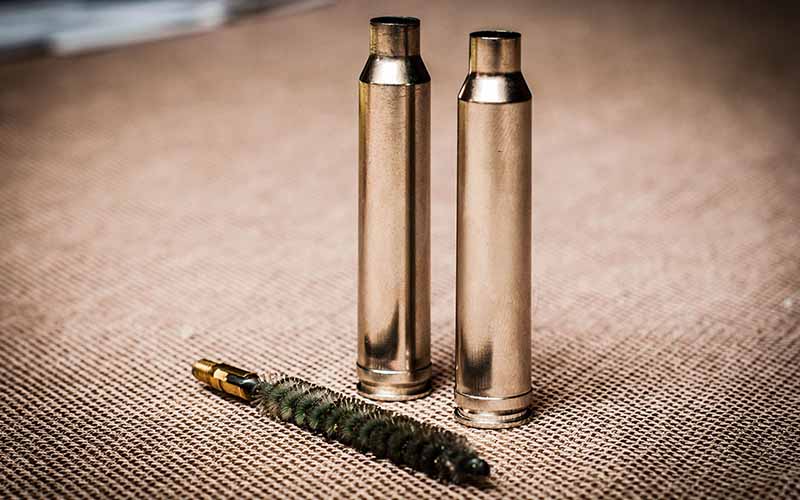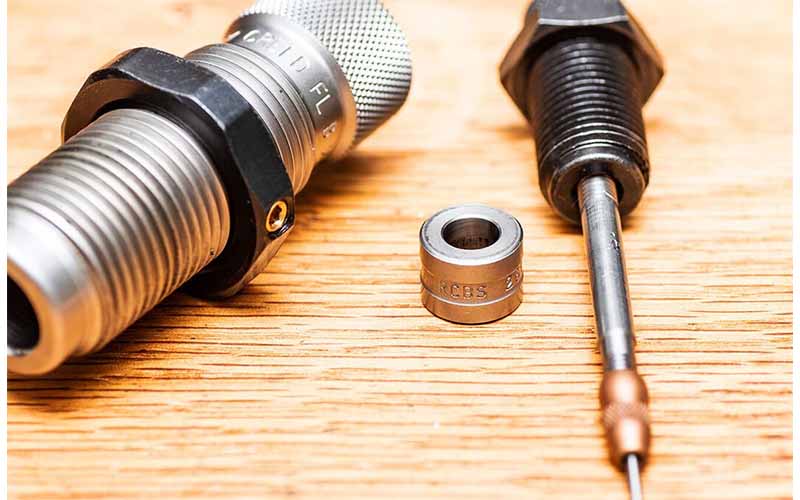
Leave that shoulder alone! Here’s how to fit ammo to your rifle using chamber concentricity.
Bottlenecked cartridges have many different means of headspacing, from using a rim—so popular among the lever-action cartridges—to the Holland & Holland belted design, to the true rimless cartridges that use the shoulder for headspacing. And while the goal for creating ammunition is to have the cartridge slip easily into the chamber, sometimes that formula doesn’t give the best possible accuracy.
If you reload your ammunition, you can control some of the dimensions, and you can give yourself an advantage in the accuracy department.

Managing Variables And Expectations
First, to understand things properly, we must realize that not all chambers are cut in the same manner. Yes, our factory guns and even custom jobs do the best to keep things as uniform as possible, but even with the modern level of CNC machining, precision go/no-go gauges and computer designs, our chambers might not be cut in a uniform manner from gun to gun. Couple that idea with the fact that our mass-produced ammunition—while I feel it is the best that is has ever been—will have slight variations from brand to brand … and even from lot to lot.
Now, the differences in accuracy might not mean a whole helluva lot to the deer hunter who reaches for the rifle once a year. He or she will often sight the rifle before the season, taking a few shots to make sure they can effectively hit a paper plate (roughly the size of a deer’s vital organs) or a bit better—and that’s fine, if that’s your hunting style. But for someone preparing for a hunt at longer ranges, or someone who is serious about target shooting or the various rifle competitions, a different mindset and level of precision is needed.
Piece By Piece
Looking at the first and most basic premise of reloading a metallic cartridge, the resizing die is used to reduce the case from its fired dimension back to the SAAMI-specified dimensions. The fired cartridge has expanded to the dimensions of the chamber as a result of the pressures generated from the firing sequence. It’s the difference between the original SAAMI dimensions and fired (chamber) dimensions that allow the cartridge to easily insert into the chamber, but it’s also that difference in dimension that reduces chamber concentricity.
When you measure the amount of expansion on some of the belted cases—famous for stretching just above the belt—you might see as much as 0.020-inch lengthening on the first firing. It’s no small wonder that we see case head separation among the belted cases, especially if we are bringing things back to the SAAMI dimension after each firing. That level of stress is too much for even the finest brass cases.

If we’re talking about a rimless case, where the shoulder handles the headspacing, it isn’t difficult to see why accuracy could suffer if the ammo and chamber aren’t quite matching up very well.
The Neck-Sizing Technique
Reloaders have long taken steps to keep cases as close to chamber conformation as possible. Early on, it was the neck sizing technique that was the most popular means. When a cartridge is “neck sized,” only the neck is reduced back to original dimension in order to provide enough tension to hold the projectile; the shoulder position and body diameter of the fired case are left “as is.”
This technique certainly works, though it does have a couple of pitfalls. Generally speaking, the neck-sized ammunition is only suitable for bolt-action rifles, which have the power to close the bolt on the ammunition of larger dimension. Lever guns and auto-loaders can quickly show the shooter the rifle isn’t happy at all with this type of ammunition.

Also, the neck-sized brass will usually be reserved for the rifle from which it was fired; the slight variations in chamber dimensions can prevent neck-sized cases from one rifle being used in another, as the bolt might not close at all. Plus, even when done properly in a bolt-action rifle, feeding can be much less smooth than regular ammunition.
For the target shooter, this might not be a huge deal, but for the hunter it could make big difference, especially when in pursuit of dangerous game, where a follow-up shot is imperative. Caveats aside, most manufacturers of reloading dies still offer a neck sizing die as an option. If you want to take the neck-sizing route, I recommend opting for a bushing die to minimize the amount of neck stretch during resizing.
Shoulder Work
The other means of obtaining the best chamber concentricity, yet still offering smooth and rapid feeding, is to measure the amount of shoulder movement from SAAMI spec to your fired cases. Redding’s Instant Indicator and Bullet Comparator is what you want to measure exactly how much your cases are stretching upon firing.
Using a SAAMI-spec dummy case as a reference point, the Comparator will quickly show you how much your fired cases vary from the specified dimensions. When used in conjunction with the Redding Competition Shellholder Set, it’ll allow the reloader to use a resizing die to shrink all the exterior dimensions of the fired case … without moving the shoulder.
It works like this: After using the dial indicator to observe the difference in your fired cases and the SAAMI-spec dimension, you’ll arrive at an average dimensional variance. So, for example, if you were to compare a half-dozen of your fired cases to the SAAMI-spec dummy, seeing a difference of 0.006 inch, you could grab the correlative shellholder and resize your cases. Redding’s Competition set of shellholders offer five different depths—ranging from 0.002 to 0.010 inch—for each family of cases. At worst, you might have to use a shoulder dimension 0.01 inch different from the observed variation, but that’ll still enhance accuracy.
What this does is resize your case—body diameter, neck dimension, etc.—while leaving the shoulder where it was after being fired. Cartridges loaded in this manner will give the benefits of a fully resized case in the feeding department but will best match your rifle’s chamber by keeping the shoulder up against the chamber wall. Yes, these cartridges will also be rifle-specific, in that they are best reserved for the rifle in which they were initially fired, but the chamber concentricity will invariably improve, and with that—at least in my experience—the accuracy, velocity spread and uniformity will also improve.
I’ve used these shellholders to cut the groups size of a .308 Winchester in nearly half, and drastically reduce the velocity spread as well. They surely have extended the life of my .300 Winchester Magnum and .300 H&H Magnum brass. In fact, when I run into a problem rifle, I reach for the silly little shellholder trick if the gun seems to be a bit finicky, and there have been several instances where a seemingly lame load has come to shine once the shoulder has been properly mated to the chamber.
Bottom line: The Comparator will run about $180 street price, and a set of the Competition Shellholders cost another $80 or so. With the two, you can easily customize your ammunition to best match the dimensions of your rifle’s chamber, resulting in an easy-to-feed cartridge that gives the best concentricity available. I feel rather confident saying that you’ll see an improvement in both accuracy and consistent velocity; this is, after all, what we reloaders seek most.
Editor's Note: This article originally appeared in the October 2023 issue of Gun Digest the Magazine.
More On Reloading:
- Tips For Reloading the .30-06 Springfield
- Loving Your Luger: Reloading the 9mm Luger
- Handloading: Tips For Reloading The 7mm Rem Mag
- How To: Tips For Reloading the .223 Remington
- Reloading Bench: The Inside On Reloading For The .30-30 Winchester

Next Step: Get your FREE Printable Target Pack
Enhance your shooting precision with our 62 MOA Targets, perfect for rifles and handguns. Crafted in collaboration with Storm Tactical for accuracy and versatility.
Subscribe to the Gun Digest email newsletter and get your downloadable target pack sent straight to your inbox. Stay updated with the latest firearms info in the industry.

![Best Concealed Carry Guns In 2025 [Field Tested] Wilson Combat EDC X9S 1](https://gundigest.com/wp-content/uploads/Wilson-Combat-EDC-X9S-1-324x160.jpg)


![Best 9mm Carbine: Affordable PCCs [Tested] Ruger Carbine Shooting](https://gundigest.com/wp-content/uploads/Ruger-Carbine-Shooting-100x70.jpg)
![Best AR-15: Top Options Available Today [Field Tested] Harrington and Richardson PSA XM177E2 feature](https://gundigest.com/wp-content/uploads/Harrington-and-Richardson-PSA-XM177E2-feature-100x70.jpg)
